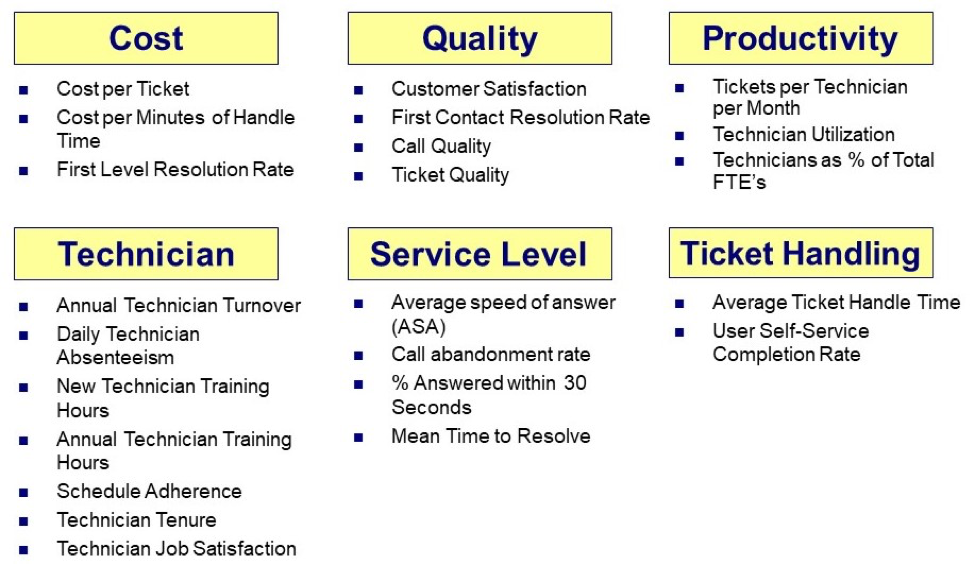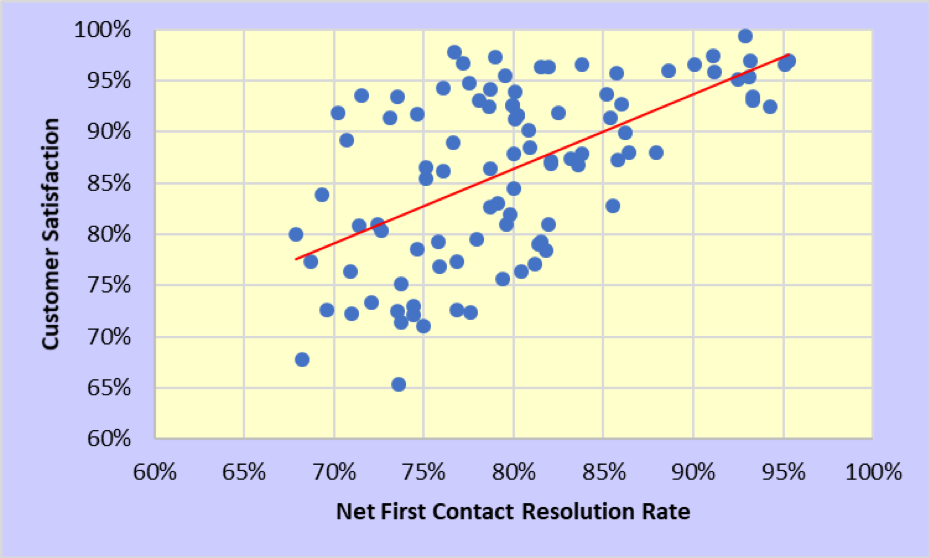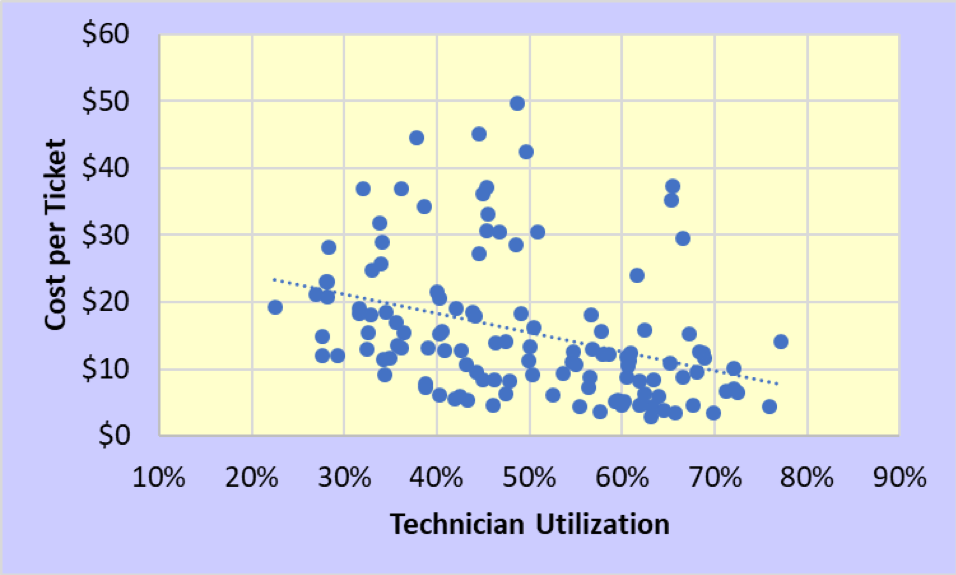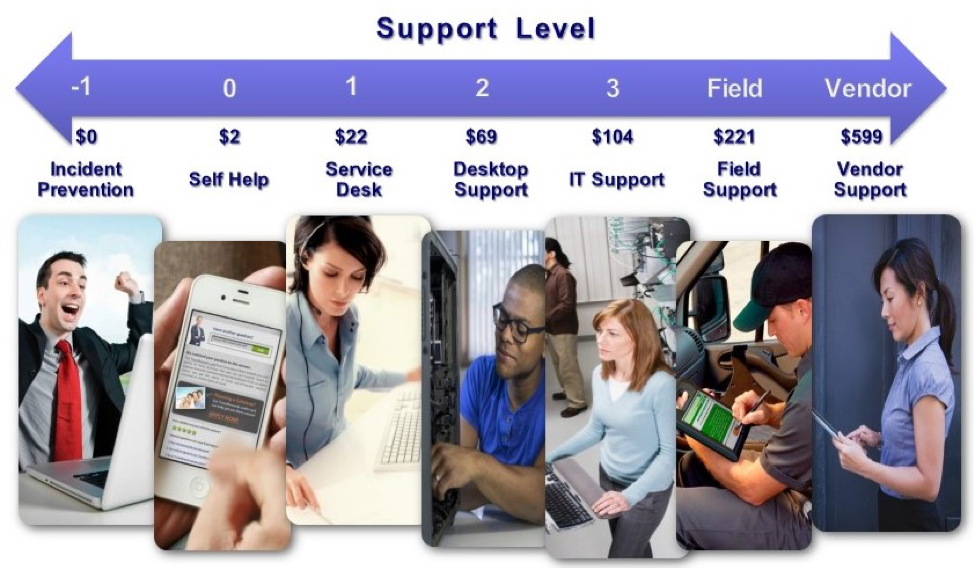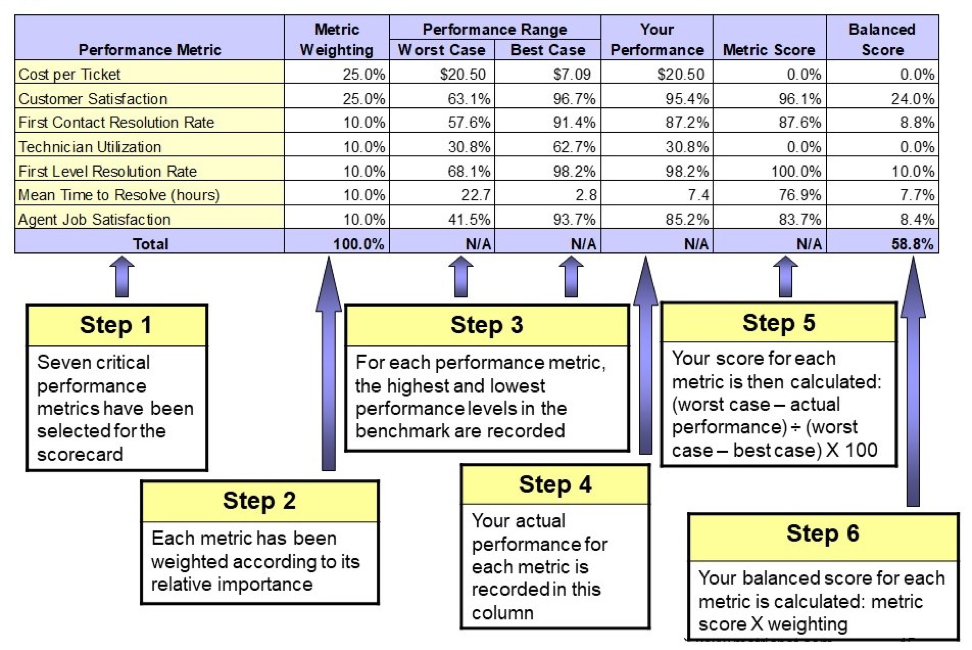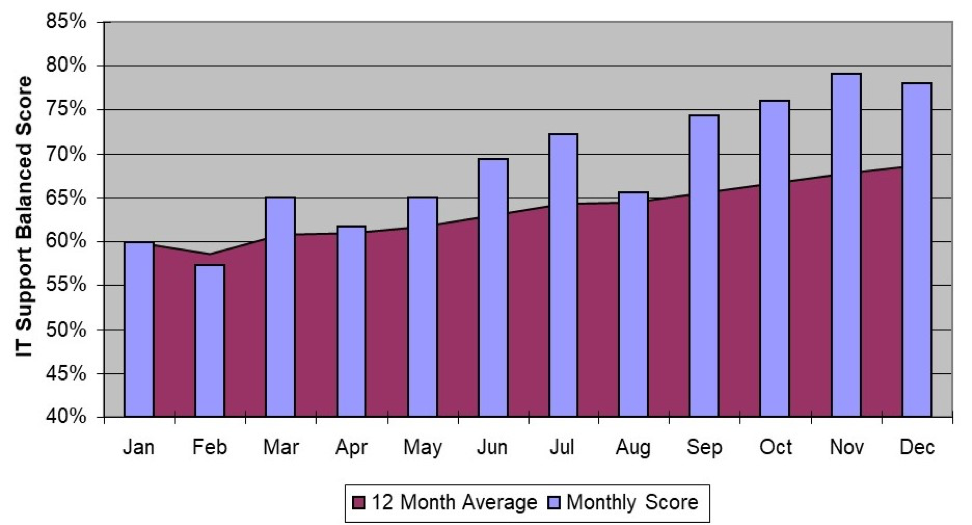Despite all the data that IT service managers have at their fingertips, most cannot answer a very basic question: How is my support organization performing?
Perhaps worse, many IT managers are unaware of the critical role—beyond mere measurement—that key performance indicators (KPIs) can and should play in optimizing service and support. This includes the ability to track and trend performance; identify, diagnose, and correct performance problems; establish performance goals; and demonstrate the ROI of support.
An increasing number of progressive IT support organizations recognize that when it comes to performance metrics, less really is more. They have discovered the 80/20 rule as it applies to IT service and support metrics: The effective application of just eight KPIs is all that is required to measure, manage, and continuously improve their organization's performance. Here they are.
The power of metrics
Many of us have heard the sage advice, "You can't manage what you don't measure." This is particularly true in IT support, where effective performance measurement is not just a necessity, but a prerequisite for effective decision making.
Despite the widespread belief in this statement, few support organizations leverage KPIs to their full potential. In fact, MetricNet's research, gathered from literally thousands of service and support benchmarks, suggests that the vast majority of support organizations use metrics to track and trend their performance—but nothing more.
Unfortunately, in this mode, IT support misses the real value of performance measurement by failing to exploit the diagnostic capabilities of KPIs.
The true potential of service and support KPIs can only be unlocked when they are used holistically, not just to measure performance, but also to:
- Track and trend performance over time.
- Benchmark performance against industry peers.
- Identify strengths and weaknesses in IT support.
- Diagnose and understand the underlying drivers of performance gaps.
- Prescribe actions to improve performance.
- Establish performance goals for both technicians and IT support overall.
- Demonstrate the ROI of service and support.
In short, performance measurement and management is a critical discipline that must be mastered for any support organization that aspires to world-class performance.
The 8 most important IT support metrics
The average IT customer support organization tracks more than 20 metrics. A list of the most common metrics is shown below (see Figure 1).
Figure 1: The 23 most commonly used IT support metrics.
This is a classic example of quantity over quality, where IT support wrongly assumes that it's doing something useful by tracking all these metrics. The vast majority of these metrics, however, are only marginally relevant at best.
The eight KPIs that really matter are the following:
- Cost per ticket
- Customer satisfaction
- First-contact resolution
- Technician utilization
- First-level resolution
- Mean time to resolve
- Technician job satisfaction
- Balanced score
We know these are the eight metrics that matter most because empirical evidence from more than 4,000 IT service and support benchmarks supports this conclusion. But here's a deeper look at why these metrics are so critically important.
Cost per ticket
Cost per ticket is the best indicator of efficiency in service and support. It is calculated by dividing the total monthly operating expense of a service desk or desktop support group by the monthly ticket volume.
Operating expense includes the following components:
- Salaries and benefits for support technicians
- Salaries and benefits for indirect personnel (team leads, supervisors, workforce schedulers, dispatchers, quality assurance and quality control personnel, trainers, and managers)
- Technology and telecom expenses (computers, software licensing fees, automatic call distributor and voice response costs, telecom headsets and handsets, etc.)
- Facilities expense (office space, utilities, insurance, etc.)
- Travel, training, and office supplies
Customer satisfaction
Customer satisfaction, likewise, is the best indicator of effectiveness in service and support. One goal of every business is to achieve the highest possible quality at the lowest possible cost.
It stands to reason, therefore, that cost per ticket and customer satisfaction should be measured on an ongoing basis. In fact, many would argue that cost and quality are the only two things that really matter.
Earlier, this article mentioned the importance of using metrics as a diagnostic tool to improve performance. So you have to ask yourself, If customer satisfaction is one of the "foundation metrics" in IT support, how can you affect it? How can you improve it? Put another way, If customer satisfaction is suffering, what is the diagnosis?
First-contact resolution
It turns out that customer satisfaction is affected by a range of other performance metrics, including call quality and mean time to resolve, to name just a couple. But the single biggest driver of customer satisfaction—by far—is first-contact resolution rate.
First-contact resolution, as the name suggests, measures the percentage of tickets resolved on first contact with the customer. The strong correlation between first-contact resolution and customer satisfaction is illustrated below, in Figure 2.
Figure 2: First-contact resolution vs. customer satisfaction.
Nine times out of ten, when customer satisfaction needs improvement, this can be achieved by increasing first-contact resolution. This is why world-class support organizations pay so much attention to this metric. They engage in a variety of tactics to continuously improve first-contact resolution, including technician training, investments in knowledge management, and remote-control tools.
Technician utilization
But what about cost per ticket, the other foundation metric in IT support? It is common knowledge that labor, i.e. personnel, is the single biggest expense in support. In fact, for the average support organization, almost 70% of all costs are labor-related, including salaries, benefits, incentive pay, and contractors.
By definition, then, labor costs are the greatest lever we have to reduce and contain the cost per ticket.
Technician utilization is the best measure of labor efficiency. Because labor costs represent the overwhelming majority of IT support expenses, if technician utilization is high, the cost per ticket will inevitably be lower.
Conversely, when technician utilization is low, labor costs—and, hence, cost per ticket—will be higher. This is illustrated in Figure 3, below.
Figure 3: Technician utilization vs. cost per ticket.
Just as world-class support organizations are obsessive about maintaining a high first-contact resolution rate, they are equally committed to keeping their technician utilization rates high. This, in turn, has the effect of minimizing cost per ticket, as illustrated above.
That said, high utilization rates, when taken to the extreme, can actually increase costs by driving technician turnover rates higher because of burnout. Whenever technician utilization approaches 60% or higher, the support organization will see relatively high technician turnover rates because it is pushing the technicians too hard.
The formula for determining technician utilization is somewhat complicated. It factors in the length of the workday, break times, vacation, sick time, training time, and a number of other factors.
But there is an easier way to approximate technician utilization.
Let's say, for example, that the technicians in a particular support desk handle an average of 500 tickets per month at an average handle time of 10 minutes. Additionally, these technicians work an average of 21 days per month, and their workday is 7.5 hours after subtracting lunch and break times.
The simplified utilization formula for the above example would work out to the following:
Once again, this is not a perfect measure of technician utilization, but the calculation is quick and easy and gets you within 2% of the true technician utilization figure.
First-level resolution
First-level resolution is the next KPI on the short list of metrics that really matter. This metric is a proxy for total cost of ownership (TCO) and is a critical measure of overall IT support efficiency.
Without this metric, it is very possible for a service desk to achieve a low cost per ticket, and hence to appear to be very efficient, but in fact to be driving a very high TCO.
Specifically, if the Level 1 service desk is achieving a low cost per ticket by transferring and escalating contacts to other support levels—desktop support, Level 2 support, vendor support, etc.—then it is also dramatically increasing the TCO.
Figure 4 below illustrates this concept.
Figure 4: Shifting left reduces total cost of ownership.
Technician job satisfaction
Technician job satisfaction is a bellwether metric that is strongly correlated with many other metrics in service and support. High levels of technician job satisfaction lead to lower turnover, lower absenteeism, lower handle times, and higher first-contact resolution rates.
This, in turn, results in lower cost per ticket and higher customer satisfaction.
Progressive support organizations therefore measure technician job satisfaction at least twice annually and take steps to ensure that they are maintaining high levels of job satisfaction, and hence high morale in the workplace.
Specifically, world-class support organizations provide training, career pathing, and coaching for their technicians at well above industry average levels.
Mean time to resolve
Mean time to resolve (MTTR) is a service-level metric that measures the average elapsed time from when a ticket is opened to when it is closed. It is typically measured in business hours, not clock hours. A ticket that is opened at 4:00 pm on a Friday and closed out at 4:00 pm the following Monday, for example, will have a resolution time of eight business hours, not 72 clock hours.
Most IT service management systems can easily measure and track MTTR. This also drives customer satisfaction, but the cause-and-effect relationship is not as strong as with first-contact resolution.
The balanced score
Can a single measure really tell us the overall performance of a support organization? The answer is yes, but as the name "balanced score" suggests, it involves combining and balancing a number of KPIs to create a single overall performance score.
The balanced score aggregates the seven metrics we have just discussed and combines them into a single, overall measure of performance. The value of this metric, when tracked over time, is that it enables IT support to determine whether overall performance is improving or getting worse.
Often, when IT support attempts to communicate its performance to other stakeholders in the business—particularly to lay people who do not understand support operations—the stakeholders quickly become overwhelmed by the minutia of such measures as speed-of-answer and ticket handle time, and they are confused about how to interpret the results. They are likely to focus on one easily understood measure such as average speed of answer and draw conclusions about the overall performance of IT support from this one (relatively unimportant) metric.
This is a classic case of missing the forest for the trees. It is therefore absolutely critical to communicate the overall performance of service and support, and the balanced score does that for you. It allows the aggregation of the seven KPIs just discussed, the normalization of those metrics, and the creation a single, all-encompassing indicator of IT support performance. In this way, IT support can track its overall performance, and in any given month, as costs go up or customer satisfaction goes down or MTTR increases, these individual measures take on a secondary level of importance because the balanced score provides a more complete and accurate portrait of IT support performance. Figure 5 below illustrates how the balanced score is calculated.
Figure 5: What the balanced score includes.
Figure 6 below illustrates the balanced score for one support organization over a 12-month period. Notice how you can see at a glance which months had improving performance (the balanced score goes up), and which months had declining performance (the balanced score goes down).
The good news for this support group is that the overall trend is in a positive direction.
Figure 6: One organization's balanced score trend over 12 months.
(Interested in building your own scorecard? Download the scorecard template.)
Put it all together
When it comes to the metrics of IT service and support, less really is more. By tracking just eight KPIs and using them diagnostically to affect continuous improvement in IT support, the job of guiding your support organization toward world-class performance can be greatly simplified.
For even more on metrics, attend my presentation, "The 80/20 Rule for Service and Support KPI’s: The Metrics of Success!" at the Fusion18 conference in St. Louis. The conference runs from September 30 to October 3, 2018. TechBeacon readers receive a $200 discount by registering with promo code TECH18.
All figures courtesy of MetricNet.
Keep learning
Choose the right ESM tool for your needs. Get up to speed with the our Buyer's Guide to Enterprise Service Management Tools
What will the next generation of enterprise service management tools look like? TechBeacon's Guide to Optimizing Enterprise Service Management offers the insights.
Discover more about IT Operations Monitoring with TechBeacon's Guide.
What's the best way to get your robotic process automation project off the ground? Find out how to choose the right tools—and the right project.
Ready to advance up the IT career ladder? TechBeacon's Careers Topic Center provides expert advice you need to prepare for your next move.


